 Okay. You’re in college, you’re poor, and you recently read the back of the Ramen package and realized that there was a downside to 19-cent-a-pack, MSG-happy deliciousness. So you switch over to the powdered packets of instant miso soup…but they’re just not the same as the sushi bar kind (and dehydrated tofu is all kinds of nasty anyway). What do you do?
Okay. You’re in college, you’re poor, and you recently read the back of the Ramen package and realized that there was a downside to 19-cent-a-pack, MSG-happy deliciousness. So you switch over to the powdered packets of instant miso soup…but they’re just not the same as the sushi bar kind (and dehydrated tofu is all kinds of nasty anyway). What do you do?
It turns out, as all miso lovers like myself will be happy to know, that making your own authentic miso soup at home is both easy and affordable. Here’s how:
MISO SOUP
INGREDIENTS
4-5 cups water
1 large strip konbu ($3.99 for a package of 12 strips) .333
1 handful bonito flakes ($3.49 for 10 individually-wrapped packages)
3-4 tablespoons miso paste ($4.99 for a tub that contains 25 servings)
½ block silken tofu, or as much as desired (1 block = $1.49)
½ teaspoons dried cut wakame ($2.99 for a 100g pack; 1 serving = 0.2g)
1 teaspoon (or ¾ inch) chopped scallions ($2.00 a pound, or 10 cents per stalk)
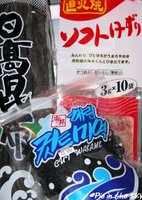
DIRECTIONS
There are two components to basic miso soup: dashi and miso paste. Dashi is a fish-and-seaweed broth made from konbu (a kind of kelp) and finely-shaved dried bonito flakes (bonito is a fish similar to tuna); it is a base for lots of Japanese sauces and soups. To make the dashi:
Add a strip of konbu to a pot of cold water (if the strip is too long, break it in half). Bring to a simmer over low heat; it should take 10-15 minutes for the water to simmer, allowing the konbu to infuse it.
As soon as the water reaches boiling, remove the konbu.
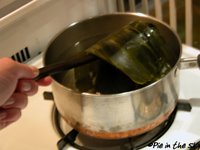
Add a handful of bonito flakes to the simmering water and remove from heat. Let the flakes steep for 1 minute, then strain them out of the broth.
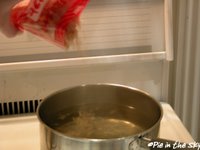
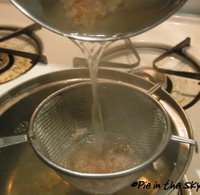
Miso paste is made from fermented soybeans. There are many varieties of miso paste; they come in colors ranging from pale yellow, mild paste to strong, dark red-brown. Beginners often start with medium-brown paste, but I’m partial to lighter pastes myself (although these require more paste per serving than stronger pastes).

Scoop about ¼ cup dashi into a small bowl, then whisk miso in until a smooth, creamy paste is achieved. Whisk mixture into dashi and return to a simmer.

Add in tofu and wakame and simmer for 2 minutes. Garnish with scallions, a splash of soy sauce if desired, and serve hot.
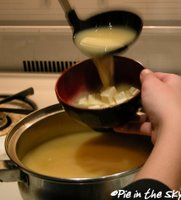
Silken tofu is advised because its smooth consistency compliments the texture of the soup. Wakame is a kind of seaweed that is very high in iodine and is good for the metabolism, as well as being delicious. It rehydrates quickly in hot soup.
This is your basic recipe. But a variety of other ingredients can spice up miso:
Chinese cabbage, cut into bite-size squares or triangles
Cabbage, cut into bite-size squares or triangles
Lettuce, cut into bite-size squares or triangles
Green onions, sliced
Onions, sliced
Leeks, sliced or chopped
Okra, chopped
Butternut squash, thinly sliced
Snow pea pods
Green beans
Daikon, thinly sliced
Potatoes, thinly sliced
Sweet potatoes, thinly sliced
Mushrooms, sliced
Bean sprouts
Some of these need to be pre-cooked before adding to broth.
This whole process takes about 20 minutes, and that’s counting the 15 that the konbu has to steep! You can make the konbu-infused water in advance and keep it refrigerated for a good long time; the completed soup will keep for about 4 days.
So there you have it! Not only is this infinitely more delicious than ramen, but it’s extremely healthy as well! Ramen noodles, which contain an average of 14 grams of fat per package (the noodles are deep-fried before dehydrating) and 45-60% of your daily sodium, have very little redeeming nutritional value. Miso, on the other hand, contains about 3 grams of fat per serving, 8 or more grams of protein, negligible carbohydrates, and the amount of sodium is under your control. Additionally, konbu and wakame are both sea vegetables that are some of the richest sources of minerals in the world: they contain high amounts of calcium, magnesium, iron, iodine, bromine, vitamins A, B1, C and E; they also bind to heavy metal toxins and carry them out of the body.
According to these prices, one very large bowl of miso soup (serving two people easily) comes to $1.72. All my items were purchased at an East Village specialty-food store, though; if I had gone to Chinatown, I bet I could have gotten everything for at least a third less. So there it is—authentic, healthy Japanese food on a college budget.



12 comments:
kate - looks like u better turn on ur word verification. Spam hell. What a post ! Now i can go make my own MSG free ( sort off ) MISO...yippee.
Thanx for the tips
Oh my! What has happened to Pie in the Sky's commets sheet! I'm so sorry hackers are messing with your nice post.
Not only for college students...I think your Dad would love this wonderful soup...now if I can just find Konu, bonito flakes, and wakme. I must get out of my box and try this healthy recipe! It will go right along with our new treadmill!
wow kate that sounds delicious. yummmmy!
is it ok if i still fall back on the ramen out of the vending machines here at work ..even though i 'm not still in college anymore? ha...
great recipe, thanks!
kate, i think with this recipe, you are officially more Asian than i :)
Yes, but as delicious as miso soup can be, nostalgia makes me partial to ramen: even as a foodie adult, I sometimes still crave uncooked strips of ramen dipped straight into the seasoning packet. Grody, I know, but it takes me back to teacher workdays when I stayed home from school and fixed my own lunch, feeling like a rebel.
Kate--what a fantastic post! And the play-by-play photos are great for a newbie.
I learned how to make dashi and miso soup when I was living with a family in Japan, but I never make it anymore. You have inspired me to give it another go, my dear. I love it with lots of veggies and spooned over brown rice (not terribly traditional, but stick to your ribs yummy).
I MADE MISO SOUP!...with a little help from my daughter...and my miso soup loving husband, loved it!
Me, myself never really liking miso soup, ate two bowl!
Thanks for bring the ingredients all the way from NY to Atl. and thanks for the phone support while I was putting it together.
If you every need an extra job, you could try teaching. You have taught your old mother a thing or two ....and that isn't an easy thing to do!
hellO!
just found this recipe sounds good BUT note
VERY IMPORTANT... that heating or boiling miso destroys most of the nutrients, you should only add the miso in at the very end!
How right you are! Amendment to this recipe: after blending miso into dashi, add tofu and return to low heat (but NOT simmering).
Thanks for the tip!
Hi there! I came across this recipe on an internet search for miso soup recipes. I've purchased the bonito and kelp and am following your recipe now, as I type. Thanks for posting it online! The photographs are really useful and I found your commentary entertaining.
Hey! thanks for the recipe. I just got through making this soup and it is wonderful.
Suggest to add the miso after soup is basially done i.e. take it off the heat and let it sit for a minute and then. This way you keep more nutrients and also get a better taste as miso is very heat sensitive and a bit too much of heat can cause a bitter taste.
Post a Comment